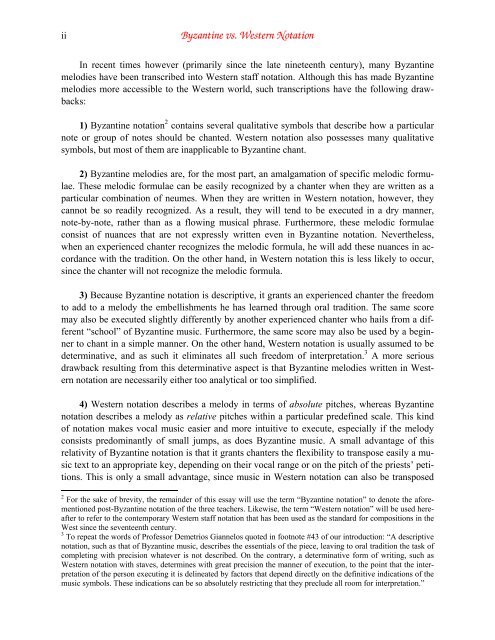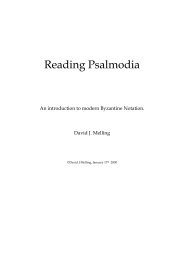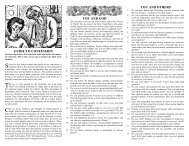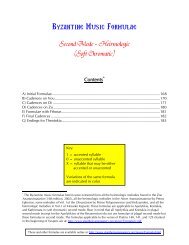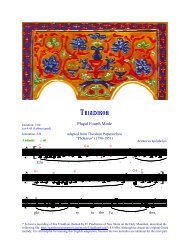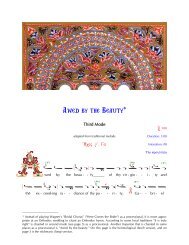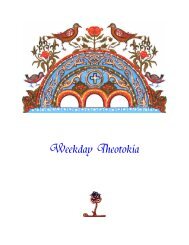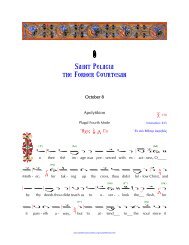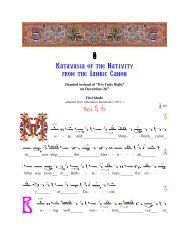Byzantine versus Western Notation - St. Anthony's Monastery
Byzantine versus Western Notation - St. Anthony's Monastery
Byzantine versus Western Notation - St. Anthony's Monastery
Create successful ePaper yourself
Turn your PDF publications into a flip-book with our unique Google optimized e-Paper software.
ii<strong>Byzantine</strong> vs. <strong>Western</strong> <strong>Notation</strong>In recent times however (primarily since the late nineteenth century), many <strong>Byzantine</strong>melodies have been transcribed into <strong>Western</strong> staff notation. Although this has made <strong>Byzantine</strong>melodies more accessible to the <strong>Western</strong> world, such transcriptions have the following drawbacks:1) <strong>Byzantine</strong> notation 2 contains several qualitative symbols that describe how a particularnote or group of notes should be chanted. <strong>Western</strong> notation also possesses many qualitativesymbols, but most of them are inapplicable to <strong>Byzantine</strong> chant.2) <strong>Byzantine</strong> melodies are, for the most part, an amalgamation of specific melodic formulae.These melodic formulae can be easily recognized by a chanter when they are written as aparticular combination of neumes. When they are written in <strong>Western</strong> notation, however, theycannot be so readily recognized. As a result, they will tend to be executed in a dry manner,note-by-note, rather than as a flowing musical phrase. Furthermore, these melodic formulaeconsist of nuances that are not expressly written even in <strong>Byzantine</strong> notation. Nevertheless,when an experienced chanter recognizes the melodic formula, he will add these nuances in accordancewith the tradition. On the other hand, in <strong>Western</strong> notation this is less likely to occur,since the chanter will not recognize the melodic formula.3) Because <strong>Byzantine</strong> notation is descriptive, it grants an experienced chanter the freedomto add to a melody the embellishments he has learned through oral tradition. The same scoremay also be executed slightly differently by another experienced chanter who hails from a different“school” of <strong>Byzantine</strong> music. Furthermore, the same score may also be used by a beginnerto chant in a simple manner. On the other hand, <strong>Western</strong> notation is usually assumed to bedeterminative, and as such it eliminates all such freedom of interpretation. 3 A more seriousdrawback resulting from this determinative aspect is that <strong>Byzantine</strong> melodies written in <strong>Western</strong>notation are necessarily either too analytical or too simplified.4) <strong>Western</strong> notation describes a melody in terms of absolute pitches, whereas <strong>Byzantine</strong>notation describes a melody as relative pitches within a particular predefined scale. This kindof notation makes vocal music easier and more intuitive to execute, especially if the melodyconsists predominantly of small jumps, as does <strong>Byzantine</strong> music. A small advantage of thisrelativity of <strong>Byzantine</strong> notation is that it grants chanters the flexibility to transpose easily a musictext to an appropriate key, depending on their vocal range or on the pitch of the priests’ petitions.This is only a small advantage, since music in <strong>Western</strong> notation can also be transposed2 For the sake of brevity, the remainder of this essay will use the term “<strong>Byzantine</strong> notation” to denote the aforementionedpost-<strong>Byzantine</strong> notation of the three teachers. Likewise, the term “<strong>Western</strong> notation” will be used hereafterto refer to the contemporary <strong>Western</strong> staff notation that has been used as the standard for compositions in theWest since the seventeenth century.3 To repeat the words of Professor Demetrios Giannelos quoted in footnote #43 of our introduction: “A descriptivenotation, such as that of <strong>Byzantine</strong> music, describes the essentials of the piece, leaving to oral tradition the task ofcompleting with precision whatever is not described. On the contrary, a determinative form of writing, such as<strong>Western</strong> notation with staves, determines with great precision the manner of execution, to the point that the interpretationof the person executing it is delineated by factors that depend directly on the definitive indications of themusic symbols. These indications can be so absolutely restricting that they preclude all room for interpretation.”


